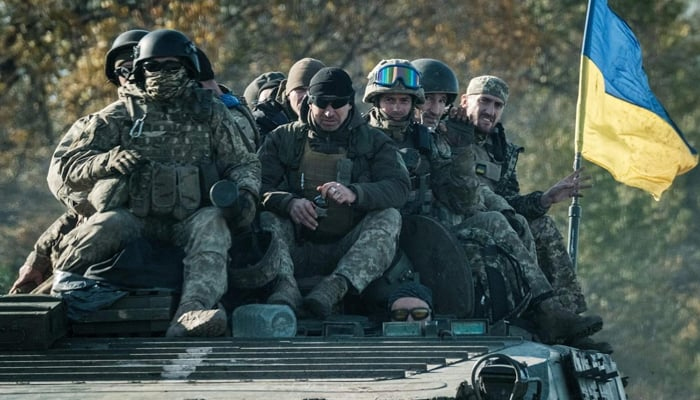Stalemate in Ukraine?
Russia still maintains dominance over roughly 18% of Ukrainian territory
As the conflict in Ukraine approaches the third year, with Ukraine’s recent winter push stalling and no notable Russian advancements, the stagnant front lines suggest a potential stalemate in 2024 as well.
Ukrainian President Zelenskyy has already accepted the limitations of Ukraine’s recent offensive, with Russia still maintaining dominance over roughly 18 per cent of Ukrainian territory. The chances of resolving the Ukrainian conflict appear dim and it is fast becoming another frozen conflict. Vladimir Putin’s influence has grown, predominantly politically.
The trajectory now hinges on political deliberations away from the conflict zone – primarily in Washington, Brussels and other capitals. The cohesive front the West presented in 2022, sustained into 2023, is now showing clear signs of strain and exhaustion. The US defence aid package remains entangled in what President Biden criticized as “petty politics” in Washington. Meanwhile, the EU’s economic assistance also hangs precariously on Hungary’s paradoxical position.
This vacillation in Western capitals has strengthened the position of Putin. His recent public displays and assertive declarations underscore his commitment to a protracted engagement. Western indecision seems to have invigorated Putin. The looming question: Does the West possess the fortitude to persistently counter him and his plan? Of course, the EU’s move to initiate membership talks with Ukraine and Moldova transcends symbolism and it signifies tacit support for Kyiv with expectations that a Ukrainian future within the EU would hamper Russia’s further victory over Ukraine.
In analyzing Washington’s dynamics, a complete policy shift seems improbable even if Trump and Republicans take charge of the administration. While speculations arise due to Trump’s surging popularity, it is crucial to note that despite his provocative rhetoric, he did not withdraw from Nato in 2016. Altering America’s longstanding transatlantic alliance would require more than just one leader’s whims. In Washington, a comprehensive policy change is not on the horizon.
The Ukraine conflict’s continuation till the end of 2024 seems very much on the cards, yet it cannot drag on indefinitely. The conflict has reinstated a major war on the European continent. By 2023, it became evident that we have reverted to an era where economies pivot significantly, prioritizing war materials. Russia’s defence spending has soared, now constituting 30 per cent of its budget, tripling since 2021. This signals that the war in Ukraine will be a prolonged and more distressing venture than anything Europe has experienced since the mid-20th century.
The coming months will reveal the resilience and capacities of both sides. At the moment, neither side holds a clear advantage; both possess the capability to neutralize each other’s advances. Russian troops might seek to advance across the entire front, particularly aiming to dominate the Donbas region entirely. Conversely, Ukraine appears poised to capitalize on its gains in the western Black Sea, safeguarding its crucial trade route to the Bosphorus. Additionally, Kyiv seems prepared to unleash further military maneuvers, aiming to unsettle Russian forces and disrupt their momentum in select sectors. The chess match continues, with each move carrying significant implications for the broader conflict’s outcome.
In the unfolding narrative, 2024 appears poised as a year of strategic recalibration for both Kyiv and Moscow. Russia’s limitations, stemming from equipment shortages and manpower constraints, suggest a delay in any major offensive until spring 2025. Concurrently, Ukraine is reliant on continued Western backing, both financial and military, to sustain its momentum. As both sides are excessively engaged in bolstering their operational capabilities, the essence of this conflict transcends mere battlefield encounters; it is emblematic of deeper confrontations.
Russia finds itself without the swift, decisive edge needed to fully subdue Ukraine. Instead, it clings to its current territorial gains, fortifying defenses and banking on Western fatigue towards Ukraine. Concurrently, recognizing the dire stakes and Moscow’s potential response to any falter, Ukraine is persisting in its resistance. As murmurs grow among European allies about amplifying aid, there is apprehension over perceived wavering in US commitment. The Transatlantic alliance teeters at a pivotal juncture, with the future of Ukraine hanging precariously in the balance, underscoring the weight of decisions made in Western capitals. The broader question emerges: as the West grapples with its commitment, will it grasp the profound ramifications of its choices on Ukraine’s fate and the global order?
Several Western defence experts suggest a series of strategic moves Ukraine might undertake in the near term. As Ukraine seeks to reestablish some kind of dominance, there is an imperative to rejuvenate battle-worn units, essential for any potential counterstrike. Simultaneously, efforts are underway to optimize Ukraine’s recruitment infrastructure, ensuring the fullest utilization of its manpower reservoir. Moreover, there is an escalating drive to amplify the output of arms and munitions.
A pronounced emphasis is also being placed on bolstering Ukraine’s capabilities to counteract the sophisticated electronic warfare tactics employed by Russian forces, encompassing jamming, interception, and reconnaissance methodologies. As the calendar inches toward summer’s onset, Ukraine is expected to deploy its freshly acquired US F16 fighter jets, a capability expected to bolster its aerial defences against Russian incursions. Ukraine’s resistance also appears intact, as it endeavors to strain Russian footholds, making operational longevity in Sevastopol’s naval enclave, the sparse airfields, and the logistical nexus at Dzankoy increasingly precarious for Moscow.
While Ukraine faces constraints, particularly in artillery shells and cutting-edge munitions, the condition of Russian forces appears even more tenuous. Ultimately, warfare tests both mettle and supply chains on both sides. For obvious reasons, Ukraine’s potential downfall is not being discussed in European capitals and Washington. Theoretically speaking, such an event would not just devastate Ukraine; it would also signal a strategic setback for the US and Nato.
Europe is facing intertwined yet distinct challenges, each unfolding at its own pace. While a full-scale Ukrainian military collapse seems improbable in the short term, Kyiv’s forces are unable to retrieve any significant territories. Anticipating a diplomatic resolution that freezes current battle lines overlooks Putin’s historical inclinations and strategies. This is another in a series of proposals being favoured by some of the EU members who appear fatigued to the point of accepting a frozen conflict on the European conflict.
The writer is a freelance contributor.
-
 Blake Lively Gushes She And Ryan Reynolds Are 'partners In Everything'
Blake Lively Gushes She And Ryan Reynolds Are 'partners In Everything' -
 Teyana Taylor Reflects On Co-parenting Journey With Ex Iman Shumpert
Teyana Taylor Reflects On Co-parenting Journey With Ex Iman Shumpert -
 Blake Shelton Recalls Being 'nervous Wreck' On Adam Sandler Film
Blake Shelton Recalls Being 'nervous Wreck' On Adam Sandler Film -
 Prince Harry's Lawyer Tells Court Daily Mail Complicit In Unlawful Acts
Prince Harry's Lawyer Tells Court Daily Mail Complicit In Unlawful Acts -
 Meghan Markle Named In Epstein Files With Ghislaine Maxwell?
Meghan Markle Named In Epstein Files With Ghislaine Maxwell? -
 Drunk Driver Tries To Snatch San Diego Deputy’s Gun During Chase
Drunk Driver Tries To Snatch San Diego Deputy’s Gun During Chase -
 After Surgery, Piers Morgan Reminded Of His Remarks About Meghan's Father's Hospitalization
After Surgery, Piers Morgan Reminded Of His Remarks About Meghan's Father's Hospitalization -
 Idris Elba Gets Honest About Managing Real-life Hijack Situation
Idris Elba Gets Honest About Managing Real-life Hijack Situation -
 Royal Family Buries King Charles' Cousin
Royal Family Buries King Charles' Cousin -
 Elizabeth Hurley Faces An Impossible Choice As Son Damian, Beau Billy Ray Cyrus Clash
Elizabeth Hurley Faces An Impossible Choice As Son Damian, Beau Billy Ray Cyrus Clash -
 Rare Pokémon Cards Worth $100k Stolen In New York Shop Robbery
Rare Pokémon Cards Worth $100k Stolen In New York Shop Robbery -
 Chevy Chase Shares Disappointment After 'SNL50: The Anniversary Special' Snub
Chevy Chase Shares Disappointment After 'SNL50: The Anniversary Special' Snub -
 Samuel L. Jackson's Old Movie Found New Life: Here's How
Samuel L. Jackson's Old Movie Found New Life: Here's How -
 Nobel Prize Snub Hardens Donald Trump's Tone On ‘peace’
Nobel Prize Snub Hardens Donald Trump's Tone On ‘peace’ -
 What's Prince Harry's Case Against The Daily Mail's Publisher?
What's Prince Harry's Case Against The Daily Mail's Publisher? -
 'Matilda' Star Mara Wilson Breaks Silence On AI's 'deepfake Apocalypse' After Being Abused
'Matilda' Star Mara Wilson Breaks Silence On AI's 'deepfake Apocalypse' After Being Abused




